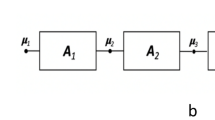Abstract
The basic principles of spiral MR image acquisition and reconstruction are summarised with the aim to explain how high quality spiral images can be obtained. The sensitivity of spiral imaging to off-resonance effects, gradient system imperfections and concomitant fields are outlined and appropriate measures for corrections are discussed in detail. Phantom experiments demonstrate the validity of the correction approaches. Furthermore, in-vivo results are shown to demonstrate the applicability of the corrections under in-vivo conditions. The spiral image quality thus obtained was found to be comparable to that obtainable with robust spin warp sequences.
Similar content being viewed by others
References
Likes RS. Moving gradient zeugmatography. US patent 1981; 4.397.343.
Ahn BC, Kim JH, Cho ZH. High-speed spiral-scand echo plannar NMR imaging-I. IEEE Trans Med Imag 1986;MI-5:2–7.
Meyer CH, Hu BS, Nishimura DG, Macovski A. Fast spiral coronary artery imaging. Mag Reson Med 1992;28:202–13.
Nishimura DG, Irarrazabel P, Meyer CH, A flow velocityk-space analysis of flow effects in echo-planar and spiral imaging. Mag Reson Med 1995;33:549–56.
Noll DC, Cohen JD, Meyer CH, Schneider W. Spiralk-space MR imaging of cortical activation. J Magn Reson Imag 1995;5:49–56.
Block W, Pauly J, Nishimura D, RARE spiral T2-weighted imaging, 1997;37:582–590.
Kerr A, Pauly J, Hu BS, Li KC, Hardy C, Meyer CH, Macovski A, Nishimura D. Real-time interactive MRI on a conventional scanner. Mag Reson Med 1997;38:355–67.
Liao JR, Pauly JM, Pelc N. MRI using piecewise-linear spiral trajectories. Mag Reson Med 1997;38:246–52.
Mason GF, Harshbarger T, Herington H, Zhang Y, Prohost G, Twieg DB. A method to measure arbitraryk-space trajectories for rapid MR imaging. Mag Reson Med 1997;38:492–6.
Ding X, Tach J, Ruggieri P, Perl J, Masaryk T. Improvement of spiral MRI with the measuredk-space trajectory. J Magn Reson Imag 1997;7:938–40.
Maeda A, Sano K, Yokoyama T. Reconstruction by weighted correlation for MRI with time-varying gradients. IEEE Trans Med Imag 1988;7:26–31.
Noll DC, Meyer CH, Pauly JM, Nishimura DG, Macovski A. A homogeneity correction method for magnetic resonance imaging with time-varying gradients. IEEE Trans Med Imag 1991;10:629–37.
Twieg DB. Thek-space trajectory formulation of the NMR imaging process with applications in the analysis and synthesis of imaging methods. Med Phys 1983;10(5):610–21.
Ljunggren S. A simple graphical representation of Fourier-based imaging methods. J Magn Reson 1983;54:338–43.
Vlaardingerbroek MT, den Boer, JA. Magnetic Resonance Imaging Theory and Practice. Berlin: Springer, 1997.
Hardy CJ, Cline HE. Broadband nuclear magnetic resonance pulses with two-dimensional spatial selectivity. J Appl Phys 1989;66:1513–6.
King KF, Foo TKF, Crawford CR. Optimized gradient wave-forms for spiral scanning. Mag Reson Med 1995;34:156–60.
Bracewell RN. The Fourier Transform and its Applications. New York: McGraw-Hill, 1986.
Rasche V, Proksa R. Reconstruction of MR images from data sampled along arbitraryk-space trajectories, In: Proc. ISMRM. 6th Annual Meeting, Sydney, 1998, p. 668.
Schomberg H, Timmer J. The gridding method for image reconstruction by Fourier transformation. IEEE Trans Med Imag 1995;14:596–607.
Hoge RD, Remi Kwan KS, Pike GB. Density compensation functions for spiral MRI. Mag Reson Med 1997;38:117–28.
Jackson JI, Meyer CH, Nishimura DG, Macovski A. Selection of a convolution function for Fourier inversion using gridding. IEEE Trans Med Imag 1991;10:473–8.
Lauzon ML, Rutt BK. Effect of polar sampling ink-space. Mag Reson Med 1996;36:940–9.
Man LC, Pauly JM, Macovski A. Multifrequency interpolation for fast off-resonance correction. Mag Reson Med 1997;37:785–92.
Norton SJ. Fast magnetic resonance imaging with simultaneously oscillating and rotating gradients. IEEE Trans Med Imag 1987;MI-6:21–31.
Noll DC, Meyer CH, Pauly JM, Nishimura DG, Macovski A. Deblurring for non-2D Fourier transform magnetic resonance imaging. Mag Reson Med 1992;25:319–33.
Noll DC. Reconstruction techniques for magnetic resonance imaging. Ph.D. Thesis, Stanford University, 1991.
Press WH, Teukolsky SA, Vetterling WT, Flannery BP. Numerical Recipes in c. New York: Cambrige University Press, 1992.
Sekihara K, Matsui S, Kohno H. NMR imaging for magnets with large nonuniformitities. IEEE Trans Med Imag 1985;MI-4:193–9.
Meyer CH, Pauly JM, Macovski A, Nishimura D. Simultaneous spatial and spectral selective excitation. Mag Reson Med 1990;15:287–304.
Schick F. Simultaneous highly selective MR water and far imaging using a simple new type of spectral-spatial excitation. Mag Reson Med 1998;40:194–202.
Simonyi K. Theoretische Elektrotechnik. Bad Langensalza: Barth Verlagsgesellschaft mdHCh, 1993.
Aldefeld B, Börnert P. Effects of gradient anisotropy in MRI. Mag Reson Med 1998;39:606–14.
Duyn J, Yihong Y, Frank JA, van der Veen JW. Simple correction method fork-space trajectory deviation in MRI. J Magn Reson 1998;132:150–3.
Norris DG, Hutchison JMS. Concomitant magnetic field gradients and their effects on imaging at low magnetic field strengths. J. Magn Reson Imag 1990;8:33–7.
Weisskoff RM, Cohen MS, Rzedzian RR. Nonaxial whole-body instant imaging. Mag Reson Med 1993;29:796–803.
King K, Ganin A, Zhou X, Berstein M. Concomitant field effect in spiral scans. Mag Reson Med 1999;41:103–12.
Bernstein MA, Zhou XJ, Polzin JA, King KF, Ganin A, Pelc NJ, Glover GH. Concomitant gradient terms in phase contrast MR: analysis and correction. Mag Reson Med 1998;39:300–8.
Author information
Authors and Affiliations
Corresponding author
Rights and permissions
About this article
Cite this article
Börnert, P., Schomberg, H., Aldefeld, B. et al. Improvements in spiral MR imaging. MAGMA 9, 29–41 (1999). https://doi.org/10.1007/BF02634590
Received:
Revised:
Accepted:
Issue Date:
DOI: https://doi.org/10.1007/BF02634590




